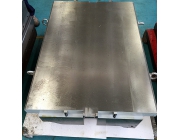

Longmen processing 02

Longmen processing 03

Longmen processing 04

Longmen processing 05

Longmen processing 06

Longmen processing 07

Longmen processing 08

Longmen processing 09

Longmen processing 01

Processing center of small proc

Processing center of small proc

Processing center of small proc

Processing center of small proc

Processing center of small proc

Processing center of small proc

Processing center of small proc


Hangzhou precision parts processing manufacturer for everyone to summarize the technical requirements for precision parts processing, there are probably the following points:
1. Surface treatment of parts:
1, parts should not be scratched or scratched on the machined surface.
2. The surface of machined thread is not allowed to have defects such as black leather, knock, buckle and burr. All surfaces of iron and steel parts that need to be painted must be removed from rust, oxide scale, grease, dust, dirt, salt and dirt before painting.
3. Before removing rust, remove the grease and dirt on the surface of steel parts with organic solvents, lye, emulsifier and steam.
4. The time interval between the coated surface and the primer can not be more than 6h after shot peening or manual rust removal.
5, riveted parts contact with each other, must be coated before the thickness of 30 ~ 40μ m antirust paint. Overlapping edges are sealed with paint, putty or adhesive. It is necessary to re coat the primers due to processing or welding damage.
Two. The sealing treatment of the parts:
1. The oil must be soaked before the assembly of the seals.
2, before assembling, strictly inspect and remove residual angles, burrs and foreign bodies during machining. Ensure that the seals are not bruised when they are loaded.
3. After bonding, the excess adhesive should be removed.
Three. The requirement of gear technology:
1. After gear assembly, the contact spots and backlash should be in accordance with the regulations of GB10095 and GB11365.
2, the gear (worm wheel) datum end and the shaft shoulder (or the end of the positioning sleeve) should be fitted with 0.05mm gauge. The perpendicularity requirement of the gear reference end and the axis should be ensured.
3, the joint between the gear box and the cover should be in good contact.
Four, screws, bolts and nuts technical requirements:
1, when screws, bolts and nuts are fastened, it is strictly prohibited to strike or use improper screwdrivers and wrenches. After fastening, the screws, nuts, screws and bolts must not be damaged.
2. Tightening fasteners requiring tightening torque must be provided with torque wrench and tightened according to the prescribed tightening torque.
3. When the same part is fastened with multiple screws (bolts), the screws (bolts) should be crossed, symmetrical, gradually and evenly tightened.
4, the flat key should be evenly contacted with the two sides of the keyway.
Five, repair welding technical requirements:
1, the defects must be thoroughly removed before repair welding, and the groove surface should be smooth and smooth without any sharp corners.
2. According to the defects of the steel castings, the defects in the repair welding area can be removed by digging, grinding, carbon arc gouging, gas cutting or machining.
3. The dirt, oil, water, rust and other dirt within 20mm within the welding area and groove must be thoroughly cleaned up.
4. During the whole process of repair welding, the temperature of the preheating zone of the steel castings should not be lower than 350° C.
5, if conditions permit, welding as far as possible at a horizontal position.
6. When welding is done, the electrode should not be swung too much.
7. When the surface welding of steel castings is done, the overlap between the welds shall not be less than 1/3 of the weld width.
